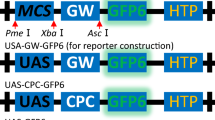Abstract
E2Tag has been used for tagging of bacterial, yeast, and mammalian proteins. A set of plant expression vectors was constructed for tagging proteins with E2Tag. Detection of E2-tagged proteins with specific antibodies inNicotiana benthamiana andNicotiana tabacum was easily done without any nonspecific background activity. No effect on the biological activity of the enzyme GUS, used as a marker, was detected. The subcellular localization of E2-tagged plant protein AtRLI2 with yet unknown functions was described.
Similar content being viewed by others
Abbreviations
- 2–5A:
-
2′,5′-oligoadenylate
- 35S:
-
cauliflower mosaic virus 35S promoter
- E2Tag:
-
novel epitope derived from a bovine papillomavirus type 1 transactivator protein E2
- GUS:
-
β-glucuronidase
- MES:
-
2(N-morpholino)ethanesulfonic acid
- nos :
-
nopaline synthase gene from theAgrobacterium tumefaciens Ti plasmid
- PBS:
-
phosphate-buffered saline
- PCR:
-
polymerase chain reaction
- RLI:
-
RNase L inhibitor
- uidA :
-
Escherichia coli gene encoding β-glucuronidase
- X-Gluc:
-
5-bromo-4-chloro-3-indolyl-beta-D-glucuronic acid
References
Aubry F, Mattéi MG, Barque JP, and Galibert F (1996) Chromosomal localization and expression pattern of the RNase L inhibitor gene. FEBS Lett 381: 135–139.
Benoit de Coignac A, Bisbal C, Lebleu B, and Salehzada T (1998) cDNA cloning and expression analysis of the murine ribonuclease L inhibitors. Gene 209: 149–156.
Bisbal C, Martinand C, Silhol M, Lebleu B, and Salehzada T (1995) Cloning and characterization of an RNAse L inhibitor. A new component of the interferon-regulated 2–5A pathway. J Biol Chem 270: 13308–13317.
Buschmann M (2003) Investigation ofArabidopsis open reading frames similar to RNase L inhibitors gene. M.Sc. thesis. Tallinn University of Technology, Tallinn, Estonia.
Carrington JC and Fredd DD (1990) Cap-independent enhancement of translation by a plant potyvirus 5′ nontranslated region. J Virol 64: 1590–1597.
Kaldalu N, Lepik D, Kristjuhan A, and Ustav M (2000) Monitoring and purification of proteins using bovine papillomavirus E2 epitope tags. Biotechniques 28: 456–462.
Koljak R, Järving I, Kurg R, Boeglin WE, Varvas K, Valmsen K, Ustav M, Brash AR, and Samel N (2001) The basis of prostaglandin synthesis in corals. J Biol Chem 276: 7033–7040.
Mäkinen K, Tamm T, Naess V, Truve E, Puurand Ü, Munthe T, and Saarma M (1995) Characterization of cocksfoot mottle sobemovirus genomic RNA and sequence comparison with related viruses. J Gen Virol 76: 2817–2825.
Örd D and Örd T (2003) Mouse NIPK interacts with ATF4 and affects its transcriptional activity. Exp Cell Res 286: 308–320.
Tammur J, Sibul H, Ustav E, Ustav M, and Metspalu A (2002) A bovine papillomavirus-1 based vector restores the function of the low-density lipoprotein receptor in the receptor-deficient CHO-ldlA7 cell line. BMC Mol Biol 3: 5.
Author information
Authors and Affiliations
Rights and permissions
About this article
Cite this article
Nigul, L., Olspert, A., Meier, M. et al. New plant vectors for protein tagging with E2 epitope. Plant Mol Biol Rep 22, 399–407 (2004). https://doi.org/10.1007/BF02772682
Published:
Issue Date:
DOI: https://doi.org/10.1007/BF02772682




